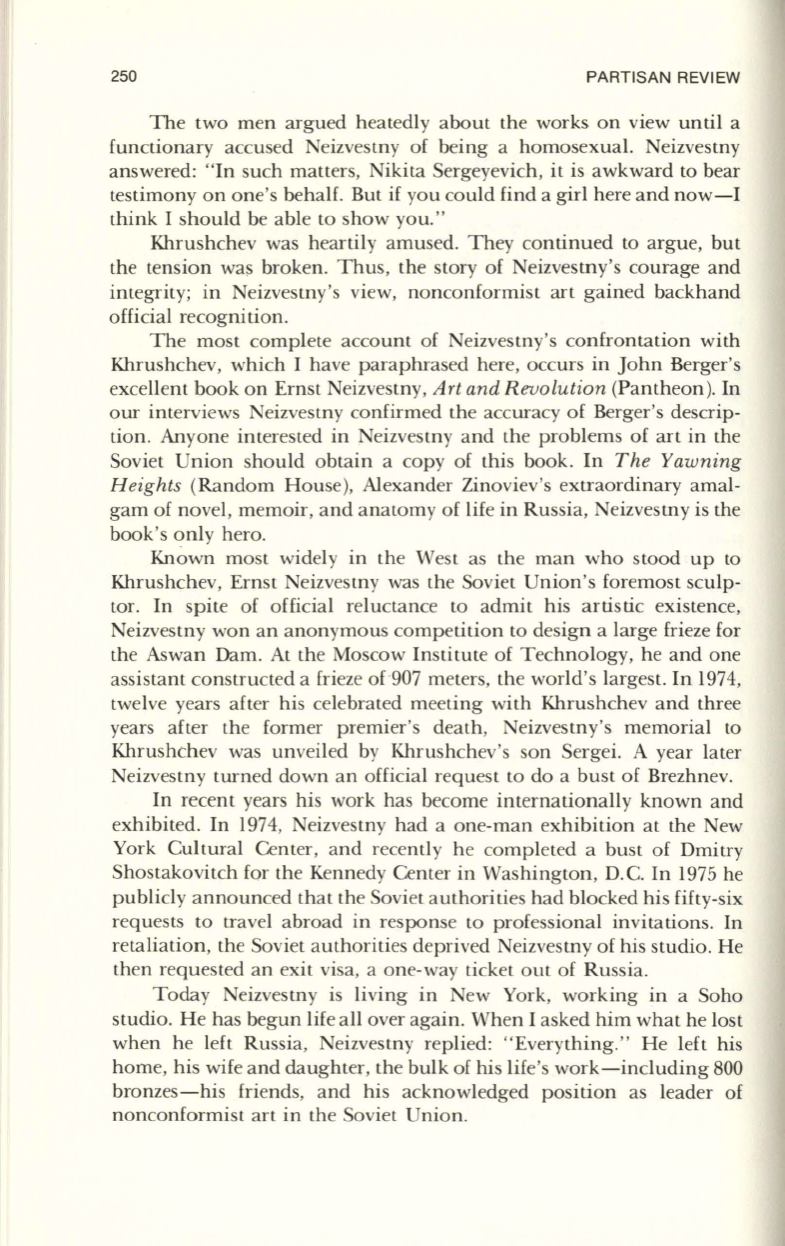
250
PARTISAN REVIEW
The two men argued heatedly about the works on view until a
functionary accused Neizvestny of being a homosexual. Neizvestny
answered: "In such matters, Nikita Sergeyevich, it is awkward to bear
testimony on one's behalf. But if you could find a girl here and now-I
think I should be able
to
show you."
Khrushchev was heartily amused. They continued to argue, but
the tension was broken. Thus, the story of Neizvestny's courage and
integrity; in Neizvestny's view, nonconformist art gained backhand
official recognition.
The most complete account of Neizvestny's confrontation with
Khrushchev, which I have paraphrased here, occurs in John Berger's
excellent book on Ernst Neizvestny,
Art and Revolution
(Pantheon).
In
our interviews Neizvestny confirmed the accuracy of Berger's descrip–
tion. Anyone interested in Neizvestny and the problems of art in the
Soviet Union should obtain a copy of this book.
In
The Yawning
Heights
(Random House), Alexander Zinoviev's extraordinary amal–
gam of novel, memoir, and anatomy of life in Russia, Neizvestny is the
book's only hero.
Known most widely in the West as the man who stood up to
Khrushchev, Ernst Neizvestny was the Soviet Union's foremost sculp–
tor.
In
spite of official reluctance to admit his artistic existence,
Neizvestny won an anonymous competition
to
design a large frieze for
the Aswan Dam. At the Moscow Institute of Technology, he and one
assistant constructed a frieze of-907 meters, the world's largest.
In
1974,
twelve years after his celebrated meeting with Khrushchev and three
years after the former premier's death, Neizvestny's memorial to
Khrushchev was unveiled by Khrushchev's son Sergei. A year later
Neizvestny turned down an official request to do a bust of Brezhnev.
In
recent years his work has become internationally known and
exhibited .
In
1974, Neizvestny had a one-man exhibition at the New
York Cultural Center, and recently he completed a bust of Dmitry
Shostakovitch for the Kennedy Center in Washington, D.C.
In
1975 he
publicly announced that the Soviet authorities had blocked his fifty-six
requests to travel abroad in response to professional invitations.
In
retaliation, the Soviet authorities deprived Neizvestny of his studio. He
then requested an exit visa, a one-way ticket out of Russia.
Today Neizvestny is living in New York, working in a Soho
studio. He has begun life all over again. When I asked him what he lost
when he left Russia, Neizvestny replied: "Everything." He left his
home, his wife and daughter, the bulk of his life's work-including 800
bronzes-his friends, and his acknowledged position as leader of
nonconformist art in the Soviet Union.


